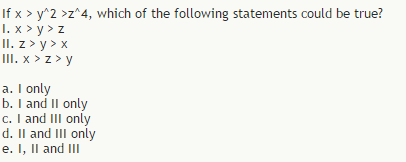Ok hmm… it-s about 9pm and I have decided I will take the diagnostic test as otherwise it is hard to find good stretches of time without disruptions. Moreover, I need to take risks. Exam is in 1 week so I’d better know what to expect. Damn let’s see… let’s see how it goes.
WOA – Got 700 on diagnostic test with only 10 days of non-full time study
Damn! This is so interesting, there might be a chance of me getting a high score.

Also super interesting to see that I made still TONS of mistakes on the test, ran out of time BIG time on Quant, and still got 700. So def. there is a BIG chance of improvement. Damn I wish I had a month in front of me or so, I’d love to try push see what is the top score I am capable of.
Fixing issues
Will keep focusing on quant as it is where I need to improve the most.
Co-primes
This is the first question I got wrong. It’s a beautiful one:

Now here the super interesting thing is the following I learned on an online forum:
Two consecutive integers are co-prime, which means that they don’t share ANY common factor but 1
That is something amazing I had never realized. Also another super interesting thing is that if you take for example an example like above, you can factorize the expression as : 2*4*6*8*10… + 1 which can be split as 2(1*2*3*4*5….*50) + 1 , which again basically is 2*50! + 1. Now one can see that h(1oo) as as factors all numbers from 1 to 50 (and some of those are prime)… hence we know that h(100) + 1 will NOT have any number smaller or equal than 50 as a factor, hence p, being smallest prime factor has to be > 50.
There is another very interesting conclusion. Which is that n! + 2 to n! + n are all NON primes for n>=2. This is because any number in that form contains in the n! side the n, which can be factorized out hence that number IS divisible by that integer hence it is NOT prime. Awesome.
Hard algebra

Ok this question I actually got right when doing the test, but I am not sure if it is because I guessed it or what. It is actually extremely complicated.
Now the important thing here is to have a very clear understanding of what happens when we exponentiate numbers.
o – remains 0. 1 – remains 1. Positive integers get really big. Negative integers get really big if exponent is even. Negative integers get really small if exponent is odd. Positive fractions less than 1 become super small positive numbers closer and closer to 0. Negative fractions higher than -1 get bigger (less negative) and closer and closer to 0. Ok, those are the cases!
First big takeaway from this question is… as I am asked what statement “could” be true. I should focus really hard in finding values of x,y,z that satisfy the statement. That’s my goal.
Just as a mental exercise I am gonna again write answer below in words. Statement 1 tells us that x is bigger than y and that y is bigger than z. As mentioned in title, , x is bigger than y squared which is bigger than z squared. It is very easy to find values that satisfy this condition, because x could be massive number, then y could be very big number, and z small number and still condition is met, because positive numbers increase when exponentiated… sure… Z will increase at a higher rate than Y, but if Y is much bigger than Z, then just doing power 4 wont be enough to catch up.
Second statement says that z is bigger than y, which is bigger than x. Ok, so… how can a number , for example y be bigger than x, if y squared is smaller than x? This is the key question. Are there any numbers that when squared become smaller? Yes. Fractions from 0 to 1. Hence lets try fractions. Can y be bigger than x but its square smaller? YES for example…. 1/3 is y, and 1/5 is x. Y is bigger than x. but when squared is smaller. Great. Now what about Z? Well same thing… we are saying that Z is bigger than y, but z to the 4th is smaller than y squared. Again, as we are doing a bigger exponent on Z, if it is a fraction frmo 0 to 1 it means it will reduce faster than Y. This means Z can be bigger than Y, but when to the power of 4th be smaller than y to the 2nd. if y is 1/3… then Z could be 1/2 …
Third statement says… can z be bigger than y (this we already know is possible) but X be bigger than the other two? Well in previous example Z was 1/5 for instance, well, if X was very high number still all conditions would apply hence this is also sufficient.
Ratios
If I am told that on a tour ratio of women to children was 5 to 2. This means that for every 2 children there were 5 W. This means the n of children in tour must be multiple of 2, and also the number of W in tour must be multiple of 5. If then I am told for every 5 children there is 11 men… this means that the num of men in tour has to be multiple of 11, and the num of children has to be multiple of 2 AND 5.
Messing with 8 and 7
For some reason my mental muntiplication of 7 and 8 is weak. This causes me to lose a lot of time and also causes mistakes that led to even getting a question wrong. 8*( is 64) a perfect square which is 2^6. This is should remember. Then 7*6 is 42… 7*7 is 49 this I remember… 7*8 is 56 this is the one I keep forgetting hmm… actually I can see that 56 = 7*8 interesting! the numbers are in order… 5,6,7,8! Maybe this will help me remember. 7*^8 = 56. 7*9 = 63 and 8*9 = 72.
Quick triangle
Perimeter of isosceles right trianlge is 16 + 16root(2) . What is the length of the hypothenuse?
Well, I can solve this with algebra well, but takes me 2min+ to solve it. I guess I will stick to algebra. However, just note there is a way to solve this quickly if one realizes that the root 2 is either frmo the sides, or hypothenuse but not both. This means that 16 + 16root(2) is A + B, then A must be either hypothenuse or sum of sides, and B must be the other. We can see that if root 2 is approx 1.4, then if sum of sides is 16, then sides will be 8 and hypothenuse will be 16*1.4 = 24 approx. Sum of shorter sides must be greater to largest at least hence we know that can’t be hence hypothenuse will b 16 and sides are each 8root(2).
SD and mean

Ok so here I know that if I add a constant k value to a list of numbers, the average of those numbers will change and become prevAv+k, and the SD will NOT change, because remember it measures the distance of num to the mean, mean will be higher, but all num will also be higher hence it all holds.
Now what I didn’t know is what happens if you increase the num on the list by a certain same percentage. Well what happens is that mean changes that %, and SD ALSO changes that %.
Some extra thoughts on standard deviation,:
1. |Median-Mean| <= SD (Makes sense because the distanec from the median to the mean will be at least the smallest out of all values)
2. Variance is the square of the standard deviation. (Means it is whatever is inside the root of the SD).
3. If Range or SD of a list is 0, then the list will contain all identical elements. And vise versa: if a list contains all identical elements then the range and SD of a list is 0. If the list contains 1 element: Range is zero and SD is zero.
4. SD is always >=0. SD is 0 only when the list contains all identical elements (or which is same only 1 element).
5. Symmetric about the mean means that the shape of the distribution on the right and left side of the curve are mirror-images of each other.
6. If we add or subtract a constant to each term in a set:Mean will increase or decrease by the same constant.SD will not change.
7. If we increase or decrease each term in a set by the same percent:Mean will increase or decrease by the same percent.SD will increase or decrease by the same percent.
8. Changing the signs of the element of a set (multiplying by -1) has no effect on SD.
9. The SD of any list is not dependent on the average, but on the deviation of the numbers from the average. So just by knowing that two lists having different averages doesn’t say anything about their standard deviation – different averages can have the same SD.
Hard Algebra
I am feeling a bit unfocused, not sure if it is because I slept less or what. Anyway let’s see if I can center otherwise I’ll have to take a nap.
Consider this question:

This one I got wrong on prep test. Actually it is quite interesting the solution.
First on eof the big lessons I take from this question is that many times plugging is required to get the solution in a case like this when a general relationship needs to be found.
- We know n is odd, so try different ones and see… clearly Not sufficient.
- We know n is even so try different odd pairs and see… clearly Not sufficient
- Find values of n non divisible by 2 and 3…. 5,7,11,13,17… and plug… and you will see remainder is 0 always.
To anlayze algebraically its possible but really si hard.Here is where one needs to realize the tricky bit. Which is that (1) means that we are multiplying consecutive even integers which means that num will always be divisible by 8. Then (2) means that we are taking 2 consecutive odd numbers which means one of those 2 odd numbers MUST be divisible by 3 (as we said n is not).
Brute Force
Check question below.

A big takeaway of this question is, first to realize that there is no quick smart solution. Factoring 75 doesn’t give us info about what sum of squares composes 75. Hence brute force is required. Answer is E.
Inequality, Absolute Value Root
So basically one important observation is that square root of (x^2) is = to Absolute(x).



